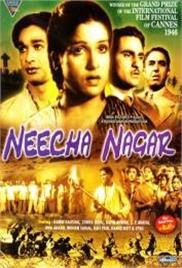Be Careful of Fake Websites. Always use HindiMovies.to domain & Join our Telegram Channel for Latest Updates.

Likes: 0
Views: 1.62K
The films takes an expressionist look at the gulf between the rich and poor in the society. The film centers on a wealthy and capacious landlord, Sarkar (Rafi Peer) who lives in a palatial estate high up on a mountain while the poor toil and starve in the valley below. The villagers of ‘Neecha Nagar’ harbor hate for Sarkar and their hatred is fueled even more by the fact that Sarkar plans to direct all the sewage into the village in order to make way for his housing project. The villagers protest this move with their head, Balraj (Rafiq Anwar) leading a movement against Sarkar’s plan. Sarkar’s daughter Maya (Uma Anand) joins the movement against her father and falls in love with Balraj. With the sewage flowing through the village, epidemic starts to spread and the lives of the villagers comes under threat. Can poor people of ‘Neecha Nagar’ survive the greed and wickedness of the rich? Can Sarkar and his malicious ways be put to an end?
Duration: 122 min
Released: 1946
IMDb Rating: 7.7/10 (65 Votes)
Genre: Drama, Hindi Movies
Stars: Rafiq Anwar, Kamini Kaushal, Uma Anand, Rafi Peer
Directors: Chetan Anand
Writers: Hayatulla Ansari
Year: 1946
Server 1 – Youtube
Server 2 – Youtube
Server 3 – Youtube
Neecha Nagar is a landmark film in the history of Indian cinema, released in 1946. It stands out not only for its compelling narrative and strong social message but also because it was one of the pioneering Hindi films to gain international recognition. Directed by C. Ramchandra and written by the talented Sher Bahadur Singh, Neecha Nagar is a drama that explores themes of social inequality and the stark divide between the rich and the poor in pre-independence India.
The film is set against a backdrop of a rural Indian village named 'Neecha Nagar,' which literally translates to 'Low City,' reflecting the social strata it portrays. The story revolves around the harsh realities faced by the villagers, spotlighting the struggles of the impoverished against the exploitative upper class. This narrative presents a vivid picture of class disparity and the ensuing conflict it breeds, making audiences reflect on the societal structures prevalent at the time.
The film features accomplished actors of that era, including Rafiq Anwar and Uma Anand in pivotal roles. Rafiq Anwar’s portrayal of the downtrodden protagonist brings depth and empathy to the story, while Uma Anand's performance as a compassionate woman caught amidst social turmoil adds emotional resonance to the film. Their compelling performances help to personify the struggles and aspirations of their characters, breathing life into the drama unfolding on screen.
Direction and Writing: The creative vision of director C. Ramchandra is palpable throughout the film. His ability to weave a narrative that is both socially conscious and artistically engaging is commendable. The screenplay and dialogues penned by Sher Bahadur Singh effectively capture the essence of the socio-political climate of the time, while skillfully humanizing the abstract concept of class struggle. Together, their collaboration results in a cinematic piece that is both entertaining and thought-provoking.
The Impact and Critical Reception: Neecha Nagar is historically significant as it won the Grand Prix at the Cannes Film Festival in 1946, making it the first Indian film to receive such an honor on the international stage. This acclaim brought global attention to Indian cinema and highlighted the country's ability to produce socially relevant films. The movie's unflinching portrayal of socio-economic issues drew both praise and critical reflection, contributing to discussions on social change during a period when India was striving for independence.
Unlike many Bollywood movies of its time, Neecha Nagar does not focus on an extensive list of songs but rather prioritizes narrative and social commentary. However, it does include music that complements the film's mood and setting, crafted to enhance the emotional impact of key scenes. The music and background score support the storyline without overwhelming it, allowing the audience to remain immersed in the dramatic tension and thematic significance.
Legacy: The film's importance lies not only in its storytelling but also in its pioneering role in Indian cinema that blazed a trail for socially conscious films. It has inspired countless filmmakers to use cinema as a medium for social critique and reform. As a drama, Neecha Nagar stands as a testament to the power of film to reflect and challenge social realities, making it a must-watch for cinema enthusiasts and scholars alike.
In summary, Neecha Nagar (1946) is a significant film that combines strong performances, thoughtful direction, and a poignant script to portray the harsh realities of societal inequities. Directed by C. Ramchandra and written by Sher Bahadur Singh, with notable performances by Rafiq Anwar and Uma Anand, it not only tells an engaging story but also marks an important moment for Indian cinema on the global stage. Its dramatic narrative and social commitment continue to resonate, embodying the spirit of storytelling that reflects societal truths.